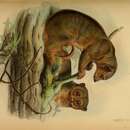Biology
provided by Arkive
The small Sulawesi cuscus lives in the hollows of trees, from where it can get easy access to forage in the forest canopy (3). It feeds primarily on fruit and is most active during the night (2) (3) (5). Unlike most species within the Phalangeridae, which are thought to be promiscuous, the small Sulawesi cuscus forms monogamous pairs (2) (3). However, all members of the family are thought to share similar reproductive traits, with the adult female producing one to two litters per year. Out of three to four, small, un-furred young that are born following a gestation period of just 20 days, only one will usually be reared. This infant will only exit the pouch after being weaned at around five to eight months (3).
Conservation
provided by Arkive
In the absence of recent surveys, it is unclear how rapidly the small Sulawesi cuscus population is declining or indeed even what the size of the population is. Consequently, it is important that further surveys are carried out, so that a more detailed assessment can be made of its conservation status (1).
While this species is technically protected by Indonesian law (1), the funding and human resources required to enforce the law are limited, particularly so in Sulawesi (6). Nonetheless, a Wildlife Crimes Unit, established by the Indonesian Department of Forestry and the Wildlife Conservation Society in 2001 to monitor wildlife trade in North Sulawesi, has been effective in reducing trade in some protected mammals (6) (7). The next step is to expand the Wildlife Crimes Unit to cover all of Sulawesi and to work with local communities to strengthen conservation awareness (7).
Description
provided by Arkive
The small Sulawesi cuscus is a diminutive, possum-like marsupial, with soft, pale buff fur (2) (3). In common with the 22 other species of cuscus and possum that comprise the family Phalangeridae, the small Sulawesi cuscus has a short face, with protruding eyes and a naked nose (2) (4). The feet have five digits, all of which are strongly clawed, except for the big toes of the hind feet. The un-clawed big toes are opposable to the remaining toes of the hind feet, as are the first two toes of the forefeet to the other three (2) (3). This enables the cuscus to firmly grip branches, which, in addition to having a long prehensile tail, makes the small Sulawesi cuscus an excellent tree climber (3) (4). The female cuscus has a well developed pouch that opens to the front and conceals two to four nipples (2).
Habitat
provided by Arkive
An arboreal animal, the small Sulawesi cuscus typically inhabits primary, and sometimes secondary, tropical lowland forest (1).
Range
provided by Arkive
Endemic to Indonesia, this cuscus occurs only on Sulawesi and the nearby islands of Sangihe, Siau and Muna (1) (2).
Status
provided by Arkive
Classified as Vulnerable (VU) on the IUCN Red List (1).
Threats
provided by Arkive
Hunting of the small Sulawesi cuscus for food, and deforestation due to agriculture and logging, are the most significant threats to this species. Given the rate at which habitat is being lost and the probable extent to which this species is over-exploited, it is likely that its population is declining significantly (1).

